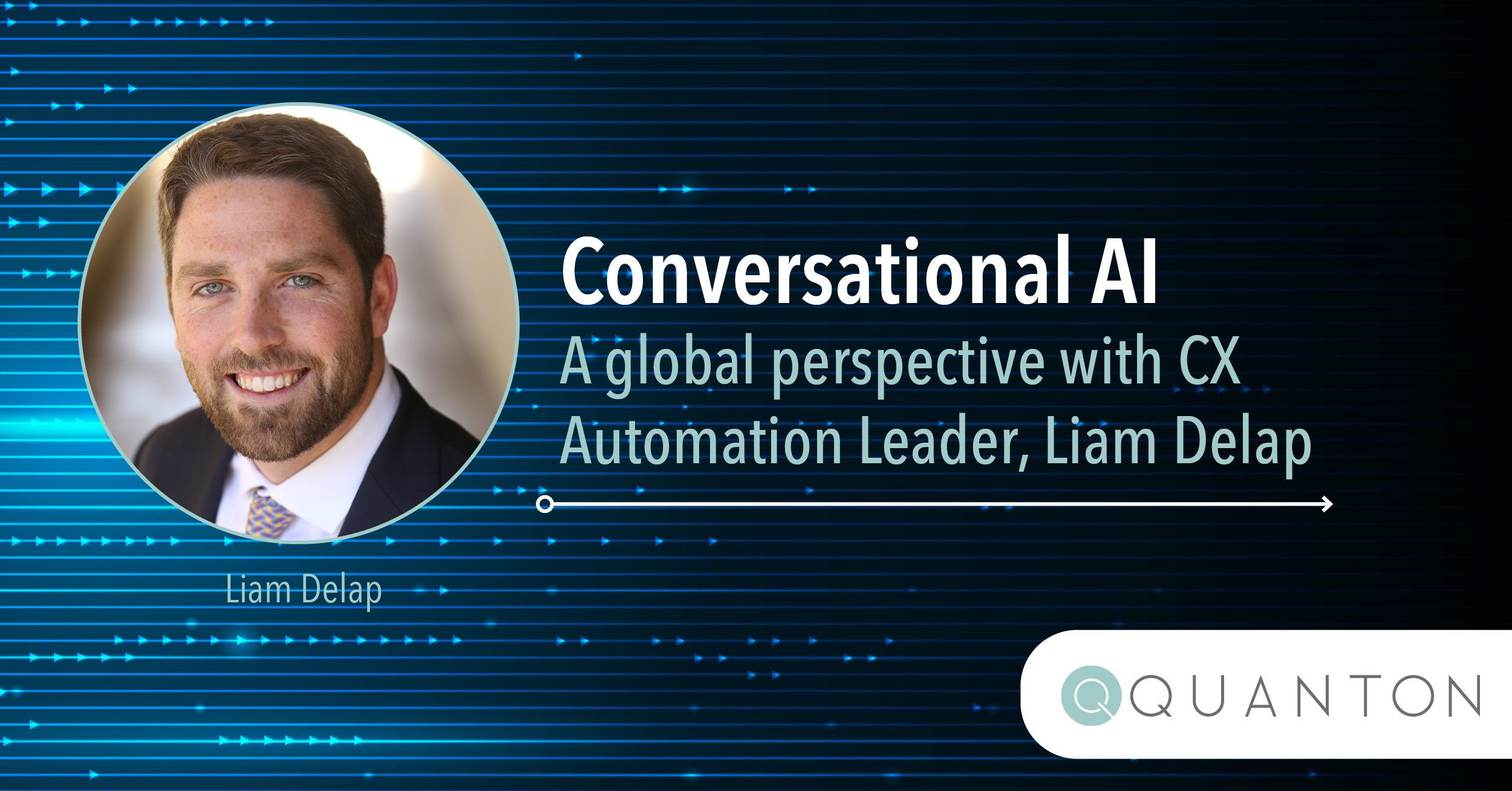
The customer experience is now a strategic battleground and Conversational AI is the enabler for personalised customer experiences, at scale.
Liam Delap, Customer experience and conversational AI evangelist shares his views on how Conversational AI is re-shaping operating models and the customer service landscape.
In the last decade companies like Uber, Netflix and Amazon who are born in the digital economy have cannibalized markets and taken market share away from existing companies, according to Liam Delap.

Referring to customer service Delap said, “By the time a customer has picked up the phone, you have likely failed them (unless their reason for call was something personal or requires empathy)”. While he used the example of a phone call, I translate this to any way a customer attempts to contact a business whether filling out an online form or emailing a customer service address.
Delap expanded this comment by explaining that what a customer is really doing when they contact a business is trying to complete a task or gain access to information and data. The best solution is enabling access to that data and the ability to complete tasks in a way that is branded and personalised. This sounds simple in theory but can be a big challenge for companies.
Conversational AI – Automating Conversational Interactions
Conversational AI is a capability that enables businesses to automate conversational interactions and provide personalised experiences – at scale.
Ultimately Conversational AI understands and replicates language, whether in written or verbal form. It is the ability to understand what an (internal or external) user wants to do and help achieve that through conversational interaction. Asking questions to obtain more information, providing responses and enabling customers to obtain information or complete tasks.
Conversational AI is not one technology, it is multiple technologies in combination, most prominently speech-to-text, intent analysis, sentiment analysis and dialogue flow, all underpinned by machine learning.
We Are NOT Talking About Chatbots.
When we talk about Conversational AI we’re referring to the ability to automate language based customer interactions.
People often think of chatbots as a relatable example. Delap aptly likened chatbots to ‘Voldemort, he who shall not be named’ and I frequently refer to the term ‘chatbot’, in relation to Conversational AI as a swear word.
When discussing chatbots two big evolutions have occurred.
First, historically the chatbot, which is channel for customer engagement and the capability to have a conversation were merged. While chatbots still exist, when we refer to Conversational AI we are referring to a capability that is mutually exclusive of the channel. You may still deploy Conversational AI capability into a chatbot channel, but you may equally deploy it into social media messengers, email channels or call centre IVR systems in any combination.
Conversational AI is agnostic of the channel it is deployed into.
Second, language technologies have taken significant leaps forward in the last decade, specifically in the areas of intent recognition, sentiment analysis and dialogue flow. The chatbots that most of us will be familiar with were often based on conversation trees, which attempted to manage conversations in a linear and logical fashion.

It's not about creating logical or linear conversations; it's about having a natural conversation.
My personal opinion is there are very few examples of effective chatbots in New Zealand and Delap shared a similar view from a US perspective. In many of the cases I have seen the chatbot is better likened to an advanced search tool that either serves information and/or directs customers to website pages.
Conversational AI is about helping people achieve meaningful outcomes, relative to your products and services.
The real aim is about creating on-demand accessibility for your customers to achieve their required outcome, whether it’s making an appointment, ordering a product, following up on an order status or getting information. This is the power of Conversational AI.
The Customer Experience is a Strategic Battleground
As the world moves towards digitisation the geographical boundaries of competition are diminishing. Uber is now every taxi company’s competition. Air BnB is every hotels competition and Netflix is now the competition for movie cinemas and any remaining film hire retailers.
The warning from Delap was that if your business is not investing in your customer experience and becoming digital first then your business is at risk.
As competition continues to increase, it is the businesses who provide the greatest ease of access, the greatest ease of use and fastest outcome who thrive.
When it comes to customer experience though, businesses won’t just be measured on the relative experience of competitors, you will be measured on best in class digital experience no-matter where a customer experiences them.
Take for example the process of applying for or opening a new account with a utilities company. If one company in the telco sector makes this a seamless, easy and simple experience, that will become my baseline to measure any other company by when I complete the same process, even if they are in a different sector. If I can do this same task so easily over there, why is it soo hard over here? That will be the question customers ask.
Conversational AI is about helping businesses achieve completely personalised and relevant experiences at scale. It is about making your experience super effortless and easy to accomplish whatever the task might be.
Delap describes it as the ultimate litmus test – ‘how easy is it to do business with your company?’. How easy is it on a scale of one to ten for a customer to complete a task? And everything we do as a business has to be laser focused on making it easier for customers.
Conversational Interaction Meets User Experience Design
Raising an interesting point, Delap suggested that focusing only on the ability to understand or have a conversation was also misguided.
Why should a customer have to write out or communicate an entire sentence? When we talk about engagement especially in digital channels and referring to the previous point on making it easy if you know that 90% of customers are looking for one of three tasks – give them a button. If you can leverage data, analytics, predictive analytics and integration the opportunities for customer experience design have a wide-ranging spectrum.
The Opportunity is Revenue Growth, Not Cost Savings.
The question is not ‘how I make my business model more efficient or effective’. If you are asking this question, you are asking the wrong question said Delap, describing this as “the narrow lense for cost saving”.
“You should make the investment into automation and artificial intelligent because it will make your experience better, more intelligent and faster” and “If you can crack the code on that, the savings will come, but more importantly the revenue will come.”
Improving your customer experience will help you achieve competitive differentiation, at which point the focus becomes market growth.
Delap referred to the example that “People use Uber because it’s easier that calling a cab”.
Accessibility, on-demand availability and automated fulfilment are factors which when combined create the foundation for scalable revenue growth.
It’s a simple formula. If you can allow customers to access your services in more places, allow your customers to engage with your services when it suits them and automatically fulfill a given request, you have the foundation for revenue growth.
I take a very similar view. If we apply the theory of diminishing returns, it will become harder and harder for businesses to extract more efficiencies for their existing operating models, and in fact taking this approach is a limiting mind-set. The alternative approach in my mind is to start from the perspective of what does a best-in-class customer experience look like, and what could be the most effective way to enable that.
Before you ask that question I also think you have to ask yourself how much courage you have, because the answer might require you to completely transition away from your current operating model. This was a sentiment echoed by Ken Grohe in my last podcast, when he said this is the foresight and vision leaders need to have to be relevant in the future.
Three Pieces Of Advice From Liam Delap
For businesses planning to start their journey, or for others who are planning to ramp up the pace of digital transformation in their operating models Delap offered three pieces of advice:

One: Start with your business strategy.
What is the current business strategy? What are the current strategic drivers for the business and how are they prioritized? These are critical factors that will help you ensure you can align RPA to your business and determine how to gain the greatest benefit from Conversational AI and business process automation in general.
If you understand your business strategy you understand what you must deliver for the business. The next question will become what the quickest way is to achieve business outcomes.
Two: Leverage your data.
Even the smallest companies have valuable data to make informed decisions on where the use of technology makes sense and what results you expect it to deliver.
Focus not only on the data you have; ask yourself what data you do not have, but you could access.
Three: Stay close to your customers.
Understand who your user personas and profiles are. Focus on opportunities for customisation and personalisation. The tone of the conversation must be in the interest of your customers.
Dalap was clear to say “they (your customers) will be the ones who will tell you where there’s opportunity, where things can be made easy and where you can fill the void.“

We covered several additional points and topics in relation to Conversational AI like the dependency on data, the customer experience design and transformational vision, that could not be weaved into this article without writing a short novel. You can listen to the 30-minute conversation and subscribe to future DX Talk episodes on your favourite podcast channel.
Much of my recent content has focussed on Intelligent Automation and I believe that Conversational AI is one of the most fundamental components to enable the capability. The final point I would conclude with, is that the importance now, is to start.







